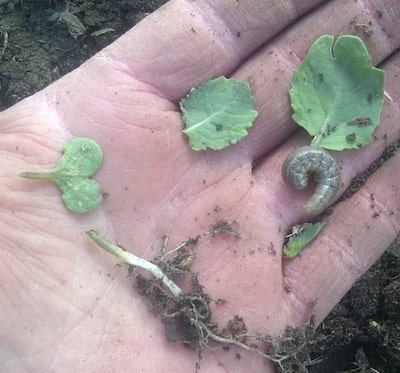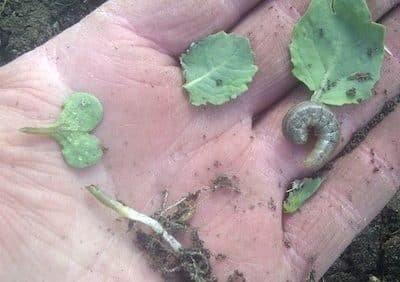Cutworms have been observed in some regions, including the southeast Peace region and west-central Saskatchewan stretching into Alberta. In western Saskatchewan, early observations suggest that cutworms are worse in fields that had lentils last year. In general, fields that had flowering plants (crops or weed patches) in August or September of the previous year may have higher cutworm counts. These flowers attract the adult moths, which lay their eggs in these areas.

Temperature and its effect on cutworm life cycles. With lots of food (green plants) and warm soils, cutworms can move quickly through their growth stages. Assessing if cutworms are at the end of their lifecycle (and will soon stop feeding) is difficult. Instead, look for signs of possible cutworm feeding in each field. Look for bare areas, holes and notches in foliage, and plants that are wilting, toppling over or completely cut off. Bare spots will begin to appear within the field, typically on south facing slopes and hilltops where the soils are warmer and soil texture is lighter. Scout the soil surrounding newly damaged plants or at the base of healthy plants adjacent to nearby damage. Then dig in the soil to confirm the presence of cutworms and take action as needed. When found, compare cutworm densities to action or economic thresholds and remember that thresholds vary by crop type. The nominal threshold has been 25-30% plant loss but the new cutworm guide has thresholds specific to crops and to cutworm species. For example, the threshold for pale western cutworm in canola is 4-5 larvae per square metre. Recognize that low seeding rates mean low plant stand densities so also weigh cutworm densities in light of your acceptable crop stand. Find scouting tips here. See page 634 of the Guide to Crop Protection to find the list of foliar products registered for cutworms in canola.
Cutworm movement from field to field. Fields beside fields with cutworms are not necessarily at risk from cutworm larvae migration, particularly those fields with a grass barrier or road in between. Movement tends to be within fields, not field to field. (Exceptions would be army cutworm and Bertha armyworm, which can move field to field, but growers typically manage these outbreaks before they get to that point.)
Saturated soil and cutworms. Some species will suffer population losses in these conditions, particularly those that overwinter as larvae. However, the most common species – red backed and pale western – overwinter as eggs, and may not be as susceptible to saturated soils.
Natural enemies of cutworms. As the new cutworm guide suggests, helpful presence of beneficial insects is another motivation to stick to thresholds. Mortality by natural enemies (parasitoids, predators, pathogens) can reduce the severity of cutworm outbreaks.
Further reading:
New guide from AAFC “Cutworm pests of crops on the Canadian Prairies”
Cutworms: Basics for scouting and spraying
Cutworm management tips

